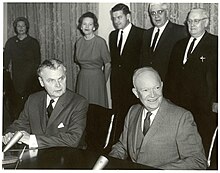Third Powerplant
After World War II, the growing demand for electricity sparked
interest in constructing another power plant supported by the Grand
Coulee Dam.
[59] One obstacle to an additional power plant was the great seasonality of the Columbia River's
streamflow.
Today the flow is closely managed—there is almost no seasonality.
Historically, about 75% of the river's annual flow occurred between
April and September.
[60] During low flow periods, the river's
discharge was between 50,000 cu ft/s (1,400 m
3/s) and 80,000 cu ft/s (2,300 m
3/s) while maximum spring runoff flows were around 500,000 cu ft/s (14,000 m
3/s).
Only nine out of the dam's eighteen generators could run year-round.
The remaining nine operated for less than six months a year.
[61] In 1952,
Congress
authorized $125,000 for Reclamation to conduct a feasibility study on
the Third Powerplant which was completed in 1953 and recommended two
locations. Nine identical 108 MW generators were recommended, but as
matters stood, they would be able to operate only in periods of high
water.
[59]
Further regulation of the Columbia's flows was necessary to make the
new power plant feasible. Water storage and regulation projects in
Canada would be needed, as well as a treaty resolving the many economic
and political issues involved. The Bureau of Reclamation and
Army Corps of Engineers explored alternatives that would not depend on a treaty with Canada, such as raising the level of
Flathead Lake or
Pend Oreille Lake, but both proposals faced strong local opposition.
[59] The
Columbia River Treaty,
which had been discussed between the U.S. and Canada since 1944, was
seen as the answer. Efforts to build the Third Powerplant were also
influenced by competition with the
Soviet Union, which had constructed power plants on the
Volga River that were larger than Grand Coulee.
[62] On
September 16, 1964, the Columbia River Treaty was ratified and included an agreement by Canada to construct the
Duncan,
Keenleyside,
Mica Dams upstream and the U.S. would build the
Libby Dam in Montana.
[63] Shortly afterward, Washington Senator
Henry M. Jackson,
who was influential in constructing the new power plant, announced that
Reclamation would present the project to Congress for appropriation and
funding.
[64]
To keep up with Soviet competition and increase the generating capacity
it was determined that the generators could be upgraded to much larger
designs. With the possibility of international companies bidding on the
project, the Soviets who had just installed a 500 MW hydroelectric
generator on the
Yenisei River
indicated their interest. To avoid the potential embarrassment of an
international rival building a domestic power plant, the Department of
the Interior declined international bidding. The Third Powerplant was
approved and its appropriation bill was signed by President
Lyndon Johnson on
June 14, 1966.
[65]
One of the new turbines in the Third Powerplant
Between 1967 and 1974, the dam was expanded to add the Third Powerplant. Beginning in
July 1967,
this involved demolishing the northeast side of the dam and building a
new fore-bay section. The excavation of 22,000,000 cu yd (16,820,207 m
3)
of dirt and rock had to be accomplished before the new 1,725 ft (526 m)
long section of dam was built. The addition made the original 4,300 ft
(1,300 m) dam almost a mile long. Original designs for the powerhouse
had twelve smaller units but were altered to incorporate six of the
largest generators available. To supply them with water, six 40 ft
(12 m) diameter
penstocks were installed.
[66] Of the new turbines and generators, three 600 MW units were built by
Westinghouse and three 700 MW units by
General Electric. The first new generator was commissioned in 1975 and the final one in 1980.
[2] The three 700 MW units were later upgraded to 805 MW by
Siemens.
[67]
Pump-generating plant
Cross-section of the Pump-Generating Plant
After power shortages in the Northwest during the 1960s, it was determined that the six remaining planned pumps be
pump-generators.
When energy demand is high, the pump-generators can generate
electricity with water from the Banks Lake feeder canal adjacent to the
dam at a higher elevation.
[68]
By 1973, the Pump-Generating Plant was completed and the first two
generators (P/G-7 and P/G-8) were operational. In 1983, two more
generators went online, and by
January 1984 the final two were operational. The six pump-generators added 314 MW to the dam's capacity.
[69] In
May 2009, the Pump-Generating Plant was officially renamed the John W. Keys III Pump-Generating Power Plant after
John W. Keys III, the U.S. Bureau of Reclamation's commissioner from 2001 to 2006.
[70]
Overhauls
A major overhaul of the Third Powerplant, which contains generators numbered G19 through G24, began in
March 2008
and will be continuing for many years. Among the projects to be
completed before the generators themselves can begin to be overhauled
include replacing underground 500 kV oil-filled cables for G19, G20 and
G21 generators with overhead transmission lines (started in
February 2009), new 236 MW transformers for G19 and G20 (started in
November 2006), and several other projects.
[71]
Planning, design, procurement and site preparation for the 805 MW G22,
G23 and G24 generator overhauls are scheduled to begin in 2011, with the
overhauls themselves to start in 2013 with the G22 generator, then G23
starting in 2014, and finally G24 starting in 2016, with planned
completions in 2014, 2016 and 2017, respectively. The generator
overhauls for G19, G20 and G21 have not been scheduled as of 2010.
[72]



No comments:
Post a Comment